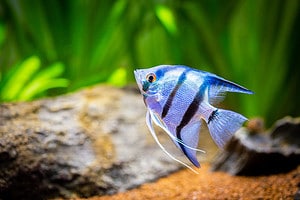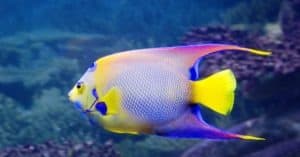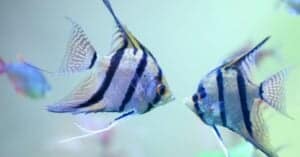Angelfish are native to the Amazon river system. They love spending the day in dimly lit, slow-moving bodies of water. One of their favorite spots to hang out is the foliage of trees that fall in the river. These freshwater fish are graceful and beautiful to watch in action.
Read on to learn 10 incredible angelfish facts.
1. Captive Adults Need 55 Gallons of Water

First, on our list of incredible angelfish facts, these fish need a lot of space. Angelfish are the perfect first pet for beginning aquarists. They’re low maintenance and easy to learn about. However, they do require a lot of room!
Angelfish grow up to be quite big. They’ll need an aquarium that holds at least 55 gallons of water. Tall aquariums work best for angelfish. The tall shape helps accommodate their body and unique shape. They also need a nice slow, gentle water flow. When decorating your angel fishes’ new home, provide them with plenty of driftwood and broadleaf plants.
2. Angelfish Are Opportunistic Feeders
Goats are known for their opportunistic attitude when it comes to eating. If a goat thinks something might taste good, it’ll take a bite! It turns out that angelfish have a similar sentiment.
Angelfish will eat anything they can fit inside their mouth. This includes smaller tank mates. They aren’t necessarily aggressive, but they don’t hesitate to eat smaller fish. That’s why aquarists have to think big when picking other community species. The best tankmates for angelfish include rainbow fish, medium-sized catfish, rasboras, and larger tetras.
3. They Have a Queen

Queen angelfish have electrifying blue and yellow colors.
©PAUL ATKINSON/Shutterstock.com
The angelfish have a queen! Or at least there’s a species of angel fish who’s rightfully earned the name of “Queen angelfish.”
Queen angelfish can grow as large as three and a half pounds! However, it’s not their large size that gave them their name. Instead, their royal title comes from what appears to be a crown sitting on their head. They have a distinct blue-ringed black spot on top of their head with a unique speckled pattern.
Queen angelfish also have striking, almost electrifying, blue and yellow colors. These shy fish can be found swimming alone or in pairs in the warm waters of the western Atlantic and the Caribbean. They hide perfectly with the exotic colors of the reef.
4. Angelfish Forage on the Ground for Meals
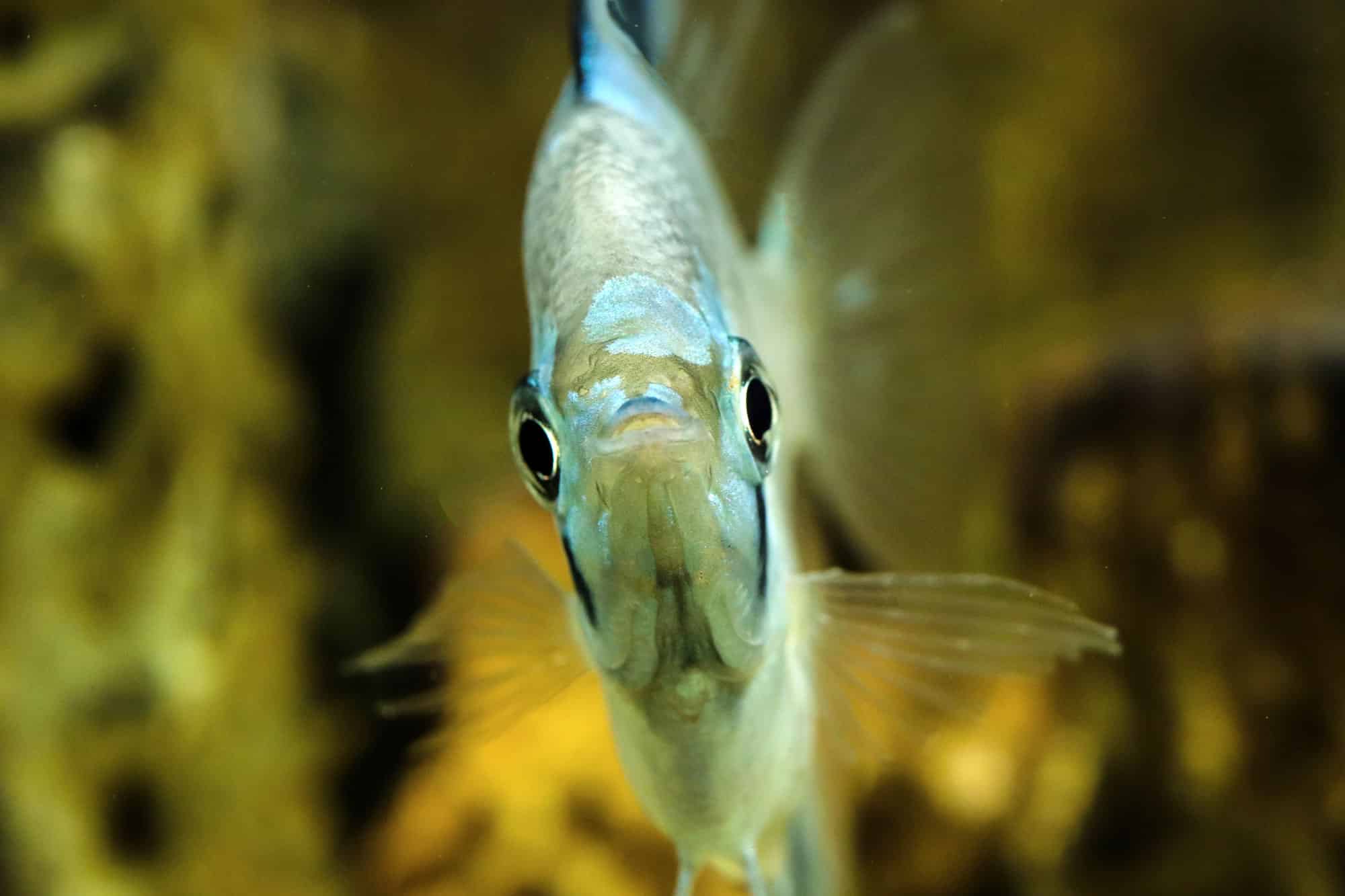
Angelfish are opportunistic feeders.
©sanches812/ via Getty Images
What do angelfish have in common with sheep, goats, cows, and horses? They all like to forage for food! Angelfish are omnivores; they eat a diet consisting of plants and small fish.
Captive angelfish are happy eating at the surface or in mid-water. However, wild angelfish take a different approach. In the wild, angel fish love foraging along the bottom of waterbeds looking for small crustaceans and worms.
5. Angelfish Parents Eat Offspring
Parents eating their offspring? This belongs on our list of incredible angelfish facts.
Unfortunately, captive angelfish have lost some of their natural rearing instincts. Aquarists must be careful and ensure that the parents don’t wind up eating the eggs or the fry. Fry is the name for the baby angelfish.
The parents don’t always eat the eggs or the fry. Both Mom and Dad will jealously guard their eggs when things are going well.
How can aquarists help things go smoothly for new angelfish? Minimizing stress is the best way to encourage good parenting instead of cannibalism. Aquarists can relieve stress by placing the breeding tank in a quiet location and covering the front.
6. Their Name Means Sail Leaf
Next for our incredible angelfish facts; they have a fitting name that describes their shape. Angelfish get their unique name from the Greek word Pterophyllum. The word roughly translates to mean “sail leaf.”
If you look at a picture of an angelfish, it’s clear that their root name directly points to their body shape. They measure anywhere from 6-8 in from their top fin to the tip of their bottom fin, making an impressive sail.
When escaping a threat, angelfish turn their “sail” at 130-180 degrees away from the threat. They use nonrandom evasive techniques.
Since they have a laterally compressed body, angelfish also appear tall and skinny instead of wide and flat. The fins on the top and bottom of their body point outward. It’s almost as if the angelfish has a diamond shape.
7. They’re Related to Humphead and Bumblebee Fish
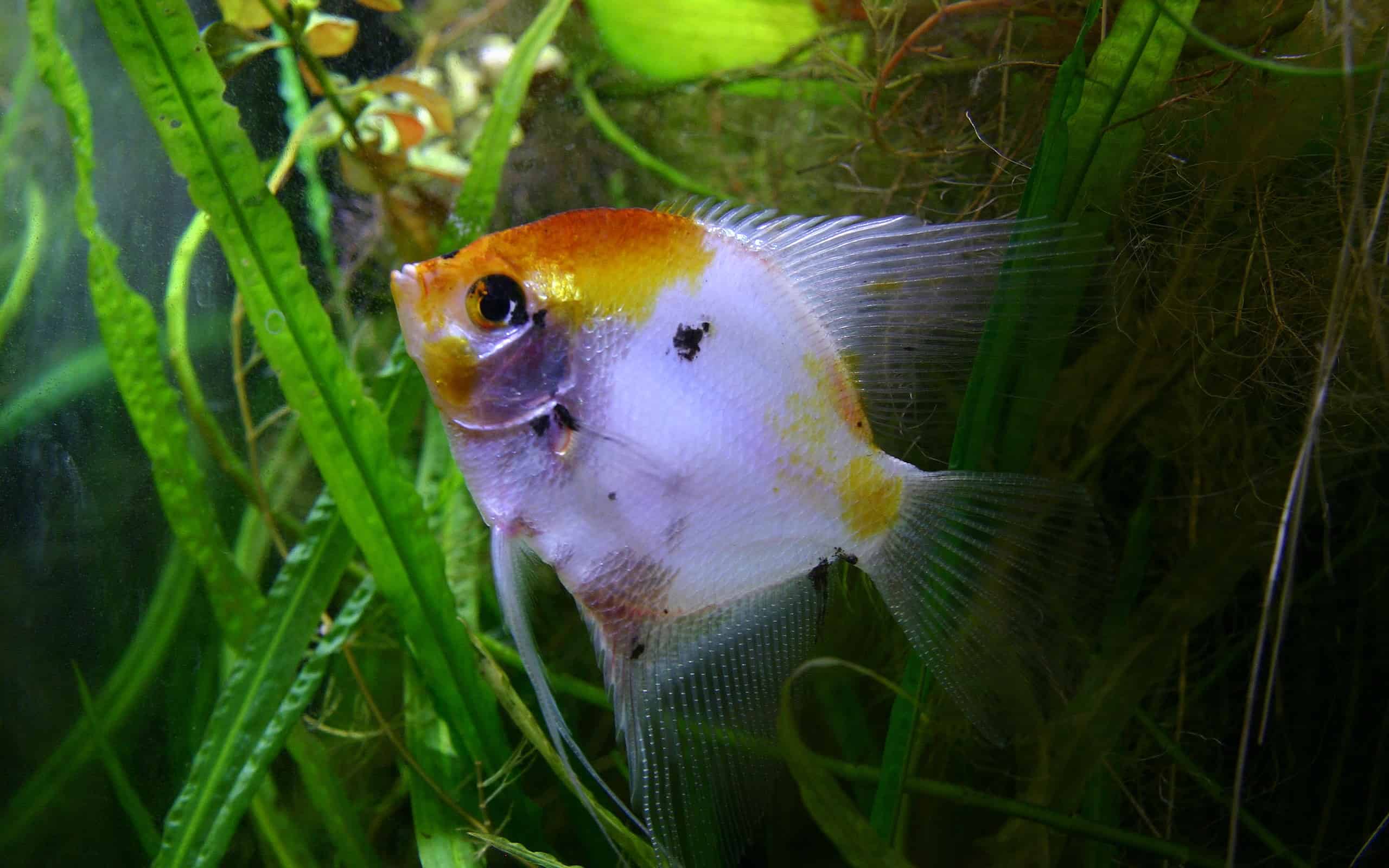
Angelfish are cichlids, just like humphead fish.
©Visa Kopu, Roxeteer / CC BY-SA 3.0 – License
Angelfish belong to a group of fish known as Cichlids. These fish are known for their voracious appetites. They eat almost anything! There are a lot of fish in the cichlid family, including humpheads and bumblebee cichlids.
Humpheads are another fan favorite among aquarium hobbyists. They earn their name thanks to a large fleshy hump sitting on top of their head.
Bumblebee fish are also great to own, but they’re very small. Bumblebee fish do best in a single species-specific tank, so they don’t become a meal.
8. Breeding Creates Their Unique Color Patterns
Years of breeding have allowed for new angelfish colors and patterns to emerge. Some of the most popular varieties include koi, marble, peppermint, leopard, and albino angelfish. Arguably, one of the most popular patterns is the zebra angelfish. There are also platinum, veil, and silver angelfish. Sometimes the silver angel fish are referred to as the wild type.
9. They Can Live Over a Decade
If you decide to get an angel fish as a pet, get ready for years of enjoyment. Angelfish can live anywhere from 8 to 12 years in the right type of environment. For long life, angelfish need plenty of room, agreeable tank mates, and a healthy supply of quality food.
Angelfish also do best when they have the least amount of stress possible. One of the best ways to keep things stress-free is by ensuring they have the right water parameters. Angelfish require a specific water temperature, adequate pH levels, and a high-quality aquarium filter.
If you give them what they need, you could have an aquatic friend for an entire decade! Other fish that can live over 10 years include armored catfish, clown loach, and figure-eight puffers.
10. Angelfish Don’t Mind Flying Solo
Last on our list of incredible angelfish facts; they do great alone. In the wild, angelfish swim in groups. But they don’t mind flying solo in a tank.
Aquarists can keep a single angelfish as a centerpiece of their tank, and it won’t negatively impact their happiness or wellbeing. Instead, keeping a single angel fish can sometimes help their demeanor.
When you let an angel fish be the star of the show, they tend to be more docile and easy-going. It can make it easier to give them agreeable tank mates.
For instance, keeping a single angelfish with a few cory catfish usually works. Sometimes you can even keep guppies and bettas too. However, even a docile angelfish might not be able to resist taking a bite of a tiny guppy.
The photo featured at the top of this post is © mendel / Creative Commons – License / Original
Thank you for reading! Have some feedback for us? Contact the AZ Animals editorial team.



